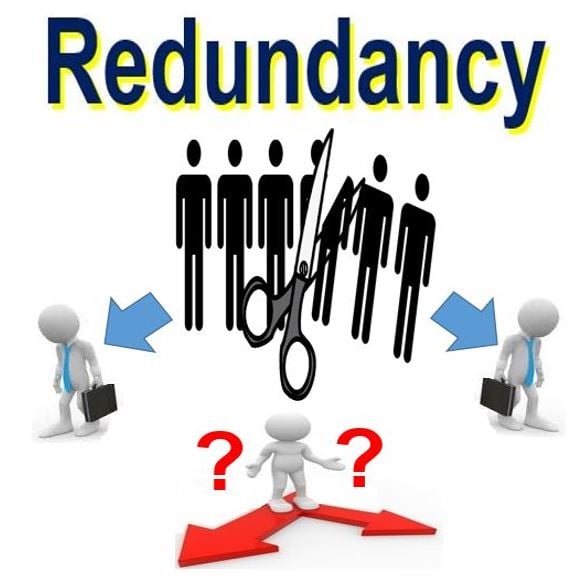Small Business Closing Employee Rights UK: What You Need to Know About Redundancy
Small Business Closing Employee Rights UK: What You Need to Know About Redundancy
Blog Article
Checking Out the Interaction Between Firm Redundancy and Organizational Adaptability for Future Growth
In the vibrant landscape these days's business globe, the complex relationship between company redundancy and business adaptability emerges as a critical variable for continual development and success. Business commonly encounter the challenge of striking a delicate balance between keeping a level of redundancy to alleviate risks and cultivating versatility to respond promptly to the ever-evolving market needs. This fragile interplay holds the essential to not just surviving in stormy times but additionally thriving despite uncertainty. As we explore the diverse measurements of this interaction, interesting understandings right into how companies browse these complexities to pave the way for future development wait for.
Relevance of Firm Redundancy
Company redundancy is an essential component that boosts organizational durability and reduces operational risks. By incorporating redundancy steps within the organizational framework, firms can much better endure unforeseen disturbances and changes in business environment. Redundancy serves as a calculated barrier, permitting companies to adjust and respond effectively to unanticipated obstacles without jeopardizing essential operations.
One key element of the importance of business redundancy is its function in making certain continuity throughout times of crisis. When confronted with unexpected changes or emergency situations, repetitive systems, resources, or personnel can step in to maintain critical functions and prevent widespread interruptions. This connection not just safeguards the business's track record and customer count on however additionally minimizes monetary losses and operational downtime.

Strategies for Business Flexibility

An additional vital strategy is investing in innovation and facilities that can sustain versatility and scalability. Implementing electronic tools, automation, and information analytics can simplify procedures, boost effectiveness, and offer valuable insights for informed decision-making. In addition, developing versatile business structures that permit for fast adjustments to market characteristics and client requirements is crucial for remaining competitive in a swiftly developing environment. By proactively recognizing prospective disturbances and opportunities, companies can proactively adapt and grow in an ever-changing service landscape.
Harmonizing Redundancy and Adaptability
Achieving an unified balance between operational redundancy and business flexibility is paramount in browsing the intricacies of a dynamic service setting. Redundancy within a business supplies a security web, making sure connection and stability in operations. Nevertheless, an extra of redundancy can bring about inefficiencies and prevent flexibility to transforming market problems. On the various other hand, business flexibility permits companies to react quickly to exterior disruptions and confiscate brand-new chances. Striking the right balance in between redundancy and adaptability is a delicate procedure that calls for a deep understanding of the company's goals, industry dynamics, and threat resistance.
To attain this equilibrium, business need to carry out regular evaluations of their procedures to determine areas where redundancy is essential for threat mitigation and where versatility can drive innovation and development. Executing versatile structures, promoting a society of continual discovering and improvement, and urging open interaction across all levels of the organization are essential approaches to harmonize redundancy and flexibility effectively. By straightening these two critical components, companies can place themselves for lasting growth and success in an ever-changing business landscape.
Instance Researches on Adaptation Success
In checking out circumstances of successful organizational adjustment, it ends up being obvious that the interaction between functional redundancy and versatility is a defining element in shaping resilient services. One engaging instance study is that of Netflix. Originally a DVD rental solution, Netflix demonstrated impressive versatility by transitioning right into a streaming system when digitalization interrupted the industry. By purposefully purchasing innovation and material development, Netflix not just endured however thrived in a quickly evolving market. Another standout instance is Amazon. Starting as an on the internet bookstore, Amazon constantly adapted its business version, broadening into varied industries such as cloud computer and expert system. This versatility allowed Amazon to stay in advance of competitors and satisfy changing customer demands. Lastly, Adobe offers a significant image of effective site adjustment. The business shifted from helpful resources selling software application licenses to a subscription-based design, making sure recurring revenue streams and boosted consumer engagement. These study highlight the significance of operational redundancy combined with organizational flexibility in fostering long-term growth and competitiveness.
Structure Strength for Future Development
Structure resilience for future development needs a tactical placement of operational procedures with market dynamics and arising trends. Companies must adapt to altering settings by fostering a culture of adaptability, advancement, and continual renovation.
Furthermore, cultivating strong partnerships with stakeholders, such as customers, workers, vendors, and the area, is essential for keeping and weathering unpredictabilities trust and support during unstable times. Effective interaction and transparency play an essential role in structure durability, as they help line up expectations and assist in partnership in browsing unpredictabilities.
In addition, companies require to prioritize knowing and advancement initiatives to upskill employees and equip them with the required tools to adapt to changing circumstances. By buying their workforce, firms can enhance their versatility and dexterity, ultimately enhancing their resilience for lasting future growth.
Final Thought

In the Learn More Here vibrant landscape of today's company globe, the complex partnership between company redundancy and business adaptability arises as a vital variable for continual development and success. Firms frequently encounter the challenge of striking a fragile equilibrium between preserving a level of redundancy to minimize dangers and promoting versatility to react promptly to the ever-evolving market demands.To achieve this balance, companies require to conduct normal evaluations of their operations to recognize areas where redundancy is needed for risk mitigation and where versatility can drive technology and development.In verdict, the interaction in between company redundancy and business versatility is critical for future growth. Building strength through a mix of redundancy and flexibility will make sure that firms are prepared for the difficulties of the future.
Report this page